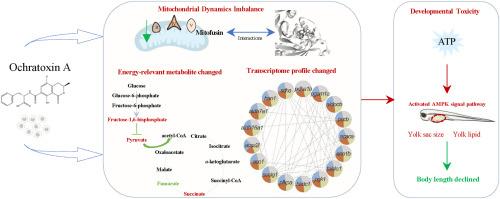Mitochondrial dynamics imbalance and energy dyshomeostasis mediated developmental toxicity of ochratoxin a in zebrafish (Danio rerio)
IF 3.5
3区 医学
Q2 FOOD SCIENCE & TECHNOLOGY
引用次数: 0
Abstract
Ochratoxin A (OTA) has been increasingly detected in foodstuffs and human samples. However, the molecular mechanisms of developmental toxicity induced by OTA remain poorly explored. Our results demonstrated that oxidative stress induced by OTA caused mitochondrial dysfunction in larvae, characterized by malformed mitochondria, and decreased mitochondrial membrane potential and complex II, IV and V activities. Central carbon metabolism analysis indicated that exposure to OTA induced energy metabolism disturbance by decreasing ATP contents and altering energy-relevant metabolite contents. Energy metabolism disturbance was further confirmed by transcriptomics analysis, with differentially expressed genes significantly enriching in glycolysis and TCA cycle. Additionally, molecular docking simulations and surface plasmon resonance analysis demonstrated that OTA interacted with mfn1 and mfn2, verifying its interference effects on mitochondrial dynamics. The insufficient energy supply induced by OTA activated AMP-activated protein kinase signal pathways, which accelerated catabolic processes, accompanied by decreases in yolk sac size and yolk lipid. Finally, insufficient energy supply caused developmental retardation of zebrafish larvae. Collectively, this study systematically elucidated the roles of mitochondrial dynamics imbalance and energy dyshomeostasis in the developmental toxicity induced by OTA, providing critical insights for refining food safety standards and therapeutic interventions.

线粒体动力学失衡和能量失衡介导的赭曲霉毒素a对斑马鱼的发育毒性
赭曲霉毒素A (OTA)已越来越多地在食品和人体样本中检测到。然而,OTA诱导发育毒性的分子机制尚不清楚。结果表明,氧化应激诱导的氧化应激导致幼虫线粒体功能障碍,表现为线粒体畸形,线粒体膜电位和复合体II、IV和V活性降低。中心碳代谢分析表明,暴露于OTA可通过降低ATP含量和改变能量相关代谢物含量引起能量代谢紊乱。转录组学分析进一步证实了能量代谢紊乱,差异表达基因在糖酵解和TCA循环中显著富集。此外,分子对接模拟和表面等离子体共振分析表明,OTA与mfn1和mfn2相互作用,验证了其对线粒体动力学的干扰作用。OTA诱导的能量供应不足激活了amp激活的蛋白激酶信号通路,加速了分解代谢过程,伴随着卵黄囊大小和卵黄脂的减少。最后,能量供应不足导致斑马鱼幼体发育迟缓。总的来说,本研究系统地阐明了线粒体动力学失衡和能量失衡在OTA诱导的发育毒性中的作用,为完善食品安全标准和治疗干预提供了重要见解。
本文章由计算机程序翻译,如有差异,请以英文原文为准。
求助全文
约1分钟内获得全文
求助全文
来源期刊

Food and Chemical Toxicology
工程技术-毒理学
CiteScore
10.90
自引率
4.70%
发文量
651
审稿时长
31 days
期刊介绍:
Food and Chemical Toxicology (FCT), an internationally renowned journal, that publishes original research articles and reviews on toxic effects, in animals and humans, of natural or synthetic chemicals occurring in the human environment with particular emphasis on food, drugs, and chemicals, including agricultural and industrial safety, and consumer product safety. Areas such as safety evaluation of novel foods and ingredients, biotechnologically-derived products, and nanomaterials are included in the scope of the journal. FCT also encourages submission of papers on inter-relationships between nutrition and toxicology and on in vitro techniques, particularly those fostering the 3 Rs.
The principal aim of the journal is to publish high impact, scholarly work and to serve as a multidisciplinary forum for research in toxicology. Papers submitted will be judged on the basis of scientific originality and contribution to the field, quality and subject matter. Studies should address at least one of the following:
-Adverse physiological/biochemical, or pathological changes induced by specific defined substances
-New techniques for assessing potential toxicity, including molecular biology
-Mechanisms underlying toxic phenomena
-Toxicological examinations of specific chemicals or consumer products, both those showing adverse effects and those demonstrating safety, that meet current standards of scientific acceptability.
Authors must clearly and briefly identify what novel toxic effect (s) or toxic mechanism (s) of the chemical are being reported and what their significance is in the abstract. Furthermore, sufficient doses should be included in order to provide information on NOAEL/LOAEL values.
 求助内容:
求助内容: 应助结果提醒方式:
应助结果提醒方式:


